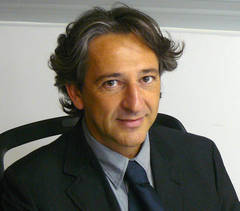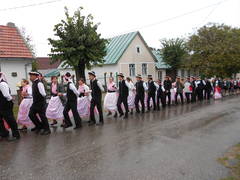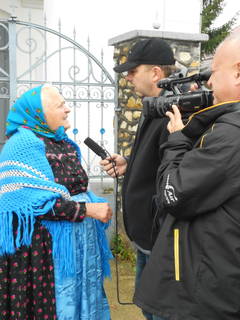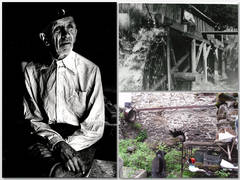24 March 2013
CreativeCH Interview: Banat Showcase

Sorin Hermon, manager of the CreativeCH's Banat showcase

Young dancers of the “Pemian” (Bohemian) ethnic group dance during the spring 2012 Kirchweih ceremony held at the Garana village: un-married girls with pink and white costumes, the boys with black suites, white shirts and hats decorated with flowers. Photo taken by Raluca Selejan. Published under Creative Commons BY-NC-SA 3.0

An old lady belonging to the “Pemian” community and dressed according to her age and social status is interviewed for the regional TV station. Photo taken by Raluca Selejan. Published under Creative Commons BY-NC-SA 3.0

Mr. Balthasar Hausner (1907-1986), 4th generation of millers at the Garana/Wolsberg village stands near his hydraulic mill. The mill stands at a crossroads between the main villages of the region, and was in use until the late 1980s for grinding wheat and maize. Photo belongs to the private archive of the Hausner family (all rights reserved).
Interview with Sorin Hermon, manager of the CreativeCH showcase in the Banat region, Romania
In a nutshell, what is the concept of your showcase?
The Banat region, extending over parts of Romania, Serbia and Hungary, is home to a multitude of past and present ethnical and cultural groups – their material culture being buried in the ground, standing vestiges or objects of traditional daily use in today’s rural communities. Each of these groups left a mark on the language, traditions, dances and other aspects of their immaterial cultural heritage as well. Therefore our concept is to systematically document, analyze and present to the wide public the richness of Banat’s cultural heritage through innovative web-based applications. The impact of such work, beyond its scientific value, will be measured in the level of local citizens’ involvement and the development of related creative industries in the area of interest.
What are special or innovative features of your showcase?
We are adopting a scientific approach aimed at presenting a comprehensive picture of the region’s cultural heritage. This is done through the integration of systematic archaeological investigation with ethnographical studies, documenting tangible remains from the past, traditional structures still in use today, costumes, dances or religious events. The information is collected in a digital repository and will be accessible to the public through a web-based system, allowing users to search and query its embedded knowledge. The technological innovations are rich metadata through which each digital object is described, and the web-based interfaces, which will allow the users different ways of interacting with the digital content. For example, keyword based search, maps, timelines or annotations / tagging. Social networks will play a substantial role as well, through access to most common sites, such as Facebook, twitter, etc.
How do you involve local organizations, students or other participants?
We have created a network of contacts including all public institutions involved in cultural heritage, and results of our work are regularly communicated to them. Representatives of such institutions, cultural offices of municipalities, cultural centers or regional museums, are also actively involved in our field work. Most of the field documentation and analysis is performed by students from the West University of Timisoara, the main actor in this showcase. The results of this work are enriching students’ study material, curricula are accordingly updated, and new research topics are proposed to students as part of their dissertation (BA, MA or PhD level). Other participants in the project are representatives of local communities, public servants in the cultural sector, and citizen interested in promoting aspects of their culture.
What are your experiences and lessons learned as yet?
Taking initiative is a key aspect of the project – the area has a huge research and economic development potential, being rich in traditions, archaeological remains and natural reserves. Citizens are willing to collaborate, share their traditions and customs and understand their roots. A main challenge is how to successfully interact with local communities. We want to create a dialogue for mutual benefits, where the researchers enrich their knowledge and the citizens in turn receive valuable outcomes, such as documented and published information about their cultural heritage, an increase in tourism and economic activities in the region, and an overall improvement of their quality of life.
How will you know that the showcase has been successful?
Measures of success of such a showcase are: in the short term – a comprehensive documentation of past and present manifestation of tangible and immaterial cultural heritage; in the mid-term an increase in the academic and research activity related to cultural heritage (archaeology, history, anthropology or economy), leading to the creation of new academic curricula and courses. In the long term we are expecting that our showcase will unlock the potential of the area for cultural tourism, a raise in citizens’ awareness of the value of their cultural patrimony, and triggers for an increase in their quality of life.
back
Latest Showcases News
20 May 2013
FOLLOW THE BANAT SHOWCASE ON FACEBOOK
28 April 2013
Etnojazz
26 April 2013
Banat at a small scale
24 March 2013
CreativeCH Interview: Banat Showcase






